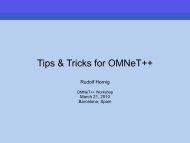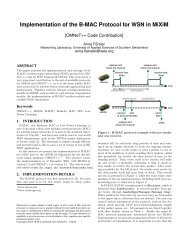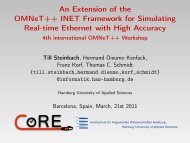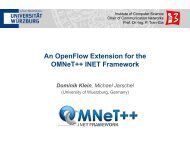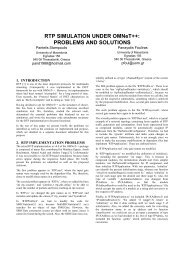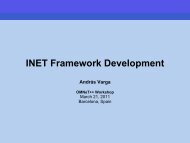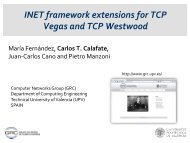A 6LoWPAN Simulation Model for OMNeT++ - International ...
A 6LoWPAN Simulation Model for OMNeT++ - International ...
A 6LoWPAN Simulation Model for OMNeT++ - International ...
Create successful ePaper yourself
Turn your PDF publications into a flip-book with our unique Google optimized e-Paper software.
6 th <strong>OMNeT++</strong> Workshop 2013<br />
A <strong>6LoWPAN</strong> <strong>Simulation</strong> <strong>Model</strong><br />
<strong>for</strong> <strong>OMNeT++</strong><br />
Michael Kirsche<br />
Computer Networks Communication Systems Group<br />
Brandenburg University of Technology, Germany
<strong>6LoWPAN</strong> and the IoT<br />
• IoT interconnecting the physical<br />
world with the digital / virtual world<br />
• All devices end-to-end connected by IPv6<br />
• IPv6 over Low Power Wireless<br />
Personal Area Networks (<strong>6LoWPAN</strong>)<br />
• “Glue between embedded and<br />
desktop world”<br />
• Missing simulation support<br />
© http://www.internet-of-things-research.eu<br />
“Traditional“ TCP/IP Protocol Stack<br />
<strong>6LoWPAN</strong> Protocol Stack<br />
HTTP RTP Application Layer<br />
Applications<br />
TCP<br />
UDP<br />
ICMP<br />
Transport Layer<br />
TCP<br />
UDP<br />
ICMP<br />
IP<br />
Network Layer<br />
IPv6<br />
<strong>6LoWPAN</strong><br />
Ethernet<br />
MAC and PHY<br />
Data Link and<br />
Physical Layer<br />
IEEE 802.15.4<br />
MAC and PHY<br />
1 • Motivation<br />
2
Preliminary Considerations<br />
• What is available / used?<br />
• Real world: IPv6 and <strong>6LoWPAN</strong>-capable OS / stacks<br />
• <strong>OMNeT++</strong> world: IPv6 support (via INET)<br />
• Other simulators: Cooja (simulate Contiki entities)<br />
NS-3 (has code??)<br />
• What is required?<br />
• Full functionality (to analyse interconnectivity & other advanced features)<br />
• Compatibility and validation<br />
• What to do?<br />
1. <strong>Model</strong> from scratch<br />
• Probably a bad choice due to abstraction and reduced functionality<br />
2. Integrate an existing implementation<br />
• First step of “integrating” (simulating) an embedded OS (Contiki) in <strong>OMNeT++</strong><br />
2 • Considerations<br />
3
Using Contiki Code with <strong>OMNeT++</strong><br />
• For this work integrate <strong>6LoWPAN</strong> implementation in <strong>OMNeT++</strong><br />
• Several approaches (refer to publication)<br />
Create a new plat<strong>for</strong>m <strong>for</strong> Contiki<br />
• How to integrate and use <strong>6LoWPAN</strong> in <strong>OMNeT++</strong>:<br />
(simplified summary)<br />
1. Define new plat<strong>for</strong>m <strong>for</strong> Contiki (omnetpp)<br />
2. Compile Contiki as a static library<br />
3. Create a “6loWPAN wrapper” <strong>for</strong> <strong>OMNeT++</strong> / INET<br />
4. Redirect Contiki’s <strong>6LoWPAN</strong> input / output functions at linking time<br />
(linker option --wrap) to appropriate <strong>OMNeT++</strong> / INET functions<br />
5. Integrate the <strong>6LoWPAN</strong> wrapper in IPv6-capable INET host<br />
6. Simulate with an IEEE 802.15.4-capable network<br />
• IEEE 802.15.4 provided by INETMANET or MiXiM / mixnet<br />
3 • Integration Approach<br />
4
The Modules’ Modus Operandi (1)<br />
1. Initialize the <strong>6LoWPAN</strong> module and according buffers<br />
2. Set function pointers from Contiki’s input / output interfaces to<br />
according <strong>OMNeT++</strong> functions<br />
3. Initialize memory management to simulate multiple Contiki instances<br />
• Instances are identified via <strong>OMNeT++</strong> gate ID<br />
• Check interfaces <strong>for</strong> IEEE 802.15.4 capabilities<br />
4. Trans<strong>for</strong>m incoming higher layer packets to Contiki’s <strong>for</strong>mat<br />
• Identify memory slot / instance and switch to last context<br />
• Data from <strong>OMNeT++</strong> message is written directly in UIP_BUFFER<br />
4 • What, When, How<br />
5
The Modules’ Modus Operandi (2)<br />
5. Call tcp_output function when trans<strong>for</strong>mation is completed<br />
• <strong>6LoWPAN</strong> handles compression and fragmentation<br />
• Link-local address of next hop is provided by INET IPv6-ND<br />
6. Finished packets are sent (from Contiki’s code, function call is<br />
redirected to <strong>OMNeT++</strong> via link-time wrapping)<br />
• Generated bytestream is captured and written in a queue<br />
7. Incoming packets from lower layers are treated in a similar way<br />
• Input function of <strong>6LoWPAN</strong> code is called instead<br />
• Memory management used to switch contexts and handle packet<br />
fragmentation / reassembly<br />
• Only reassembled packets are sent to <strong>OMNeT++</strong>, fragments are<br />
treated by Contiki’s <strong>6LoWPAN</strong> code<br />
4 • What, When, How<br />
6
In conclusion…<br />
• We provide a <strong>6LoWPAN</strong><br />
simulation model that supports:<br />
• TCP, UDP, ICMP<br />
• Integration into INET<br />
• Use with INETMANET / MiXiM<br />
• IPv6, HC1, HC06 compression<br />
• Fragmentation<br />
• Limited neighbour discovery<br />
(without context distribution)<br />
• … a first step <strong>for</strong> an integration<br />
of Contiki into <strong>OMNeT++</strong> …<br />
• Current problems:<br />
• No extension headers<br />
• Code still pretty buggy<br />
• Integration via static library<br />
• Future plans:<br />
• Integration via dynamic library<br />
• RFC 6775 extensions<br />
• Add more protocols from Contiki<br />
• Simulate more IoT scenarios<br />
with <strong>OMNeT++</strong><br />
5 • The End<br />
7



